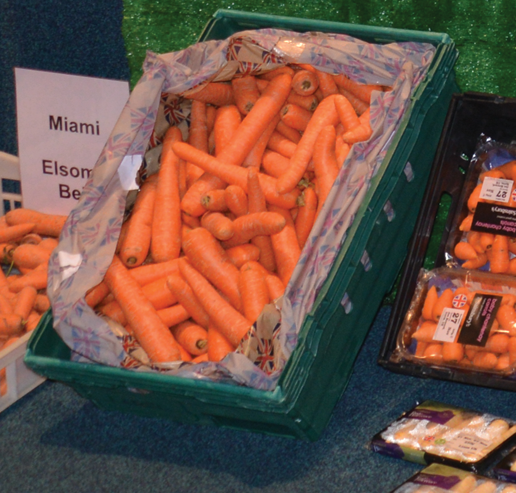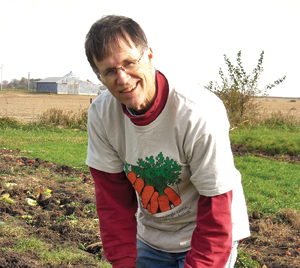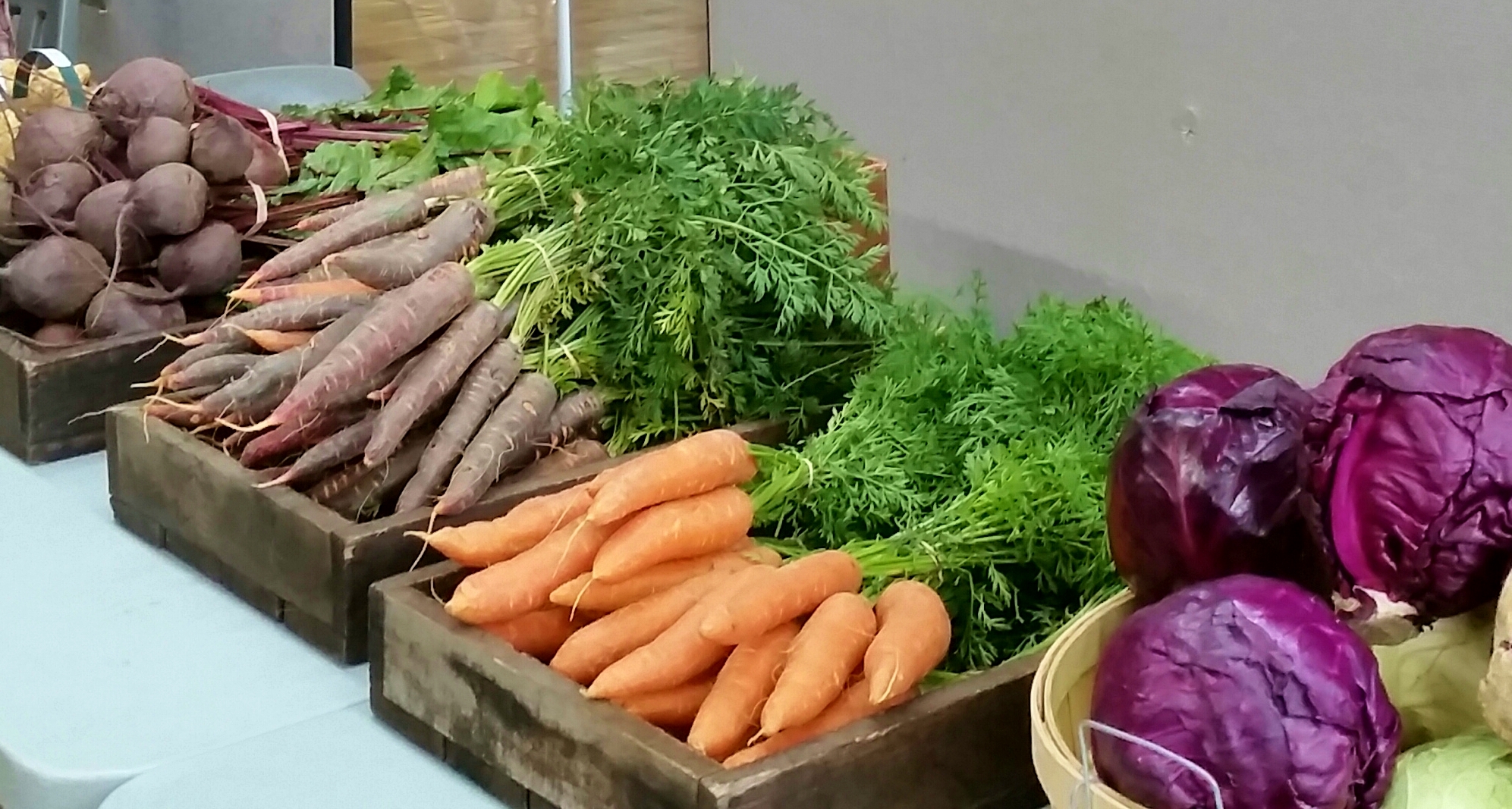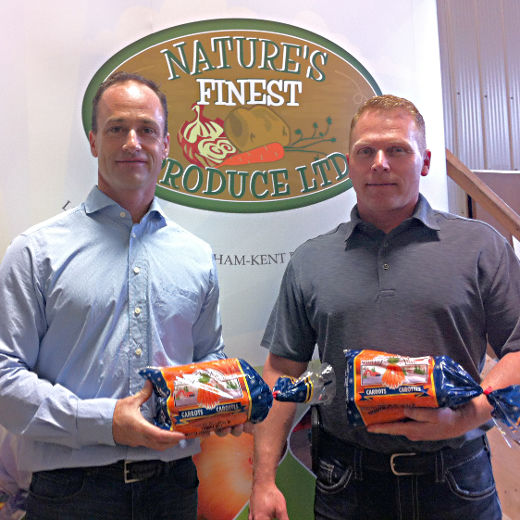Dec 6-8, 2016
Devos Place Conference Center
Grand Rapids, Michigan
The PREMIERE SHOW for
Fruit and Vegetable Growers, Greenhouse Growers and Farm Marketers!

Dec 6-8, 2016
Devos Place Conference Center
Grand Rapids, Michigan

| March 19-22, 2017 Doubletree Hotel Bakersfield, California, USA |
The 38th International Carrot Conference will be held at the Double Tree Hotel in Bakersfield, California, March 19-22, 2017. The conference will be hosted by the University of California Cooperative Extension and the California carrot industry. The International Carrot Conference is a biennial meeting that attracts people from private industry, government, and universities from throughout the world. The conference is an excellent way for people to exchange ideas and concerns in all aspects of carrot production. Topics such as breeding, new products, production, and pest management are discussed in formal paper sessions, poster sessions, and a field tour. There will also be ample opportunity to interact with others in social gatherings.
California is a major carrot production region and is the home of two of the world’s largest carrot producers. The California carrot industry created the California Fresh Carrot Advisory Board to fund research to address various production problems such as weeds, diseases, nematodes, and plant breeding. In collaboration with the Board, the University of California has become leader in carrot research. The California Fresh Carrot Advisory Board also funds projects at other universities and USDA centers.
The 38th International Carrot Conference will be held in Bakersfield California, which is located in the heart of carrot production for the United States. Beside carrots, vegetable crops such as processing tomatoes, potatoes, garlic and onions, melons and a plethora of winter vegetables are grown in Kern County. Almonds, grapes and citrus are actually the largest crops grown in Kern County. We hope to make time during the conference so people can see many of the crops here. Bakersfield is also central to many locations in California. Beaches are a couple of hours away, as is Los Angeles. The Sierra Nevada Mountains and Mojave Desert are just an hour away

By Mike Hornick
Empoli, Italy-based Irplast has introduced an adhesive tape that wraps portions of produce.
The product, dubbed Food Contact Tape, allows shippers to label and group together items like bananas and to promote their brand and information on the product.
The tape is offered as an alternative to straps and elastic bands, trays and transparent wraps. It aims to safeguard the organoleptic properties of food, according to a news release, and to decrease the quantity of secondary packaging.
Irplast adopted the British Retail Consortium standard in 2015 for the production process of its prevalent packaging tapes. Its research has involved ink manufacturers INX and SunChemical and the adhesive producer Henkel.
This tape has been declared eligible for direct contact with fruit and vegetables with peel, following an analysis by the commissioned laboratory CSI S.p.A, Milan, Italy. That analysis found no contamination or organoleptic alteration from the tape to the food product.
The tape can stick to various fruits and vegetables without leaving residue once removed, according to Irplast.
“We are dealing with a major innovative element for the fruit and vegetables market, especially in terms of increased functionality and significant environmental benefits, thanks to the decrease of secondary packaging,” Luca de Bartolo, Irplast’s chief operating officer, said in the release.
SOURCE: The Packer

By Bonnie Brost, For the News Tribune
The carrot is one of the world’s most popular vegetables, second only to the potato. The carrot has been declared 2016’s “Vegetable of the Year” by the Duluth Community Garden Program and the National Garden Bureau to encourage people to plant and eat the common root vegetable.
Read the story here:
http://www.duluthnewstribune.com/news/4053645-nutrition-carrots-pack-healthy-punch

Scientists unveiled Monday the gene in carrots that gives rise to carotenoids, a critical source of Vitamin A and the pigment that turns some fruits and vegetables bright orange or red.
Unpoetically dubbed DCAR_032551, the star gene emerged from the first complete decoding of the carrot genome, published in the scientific journal Nature Genetics.
“Vitamin A deficiency is a global health challenge,” the study pointed out.
“Its plentiful carotenoids make carrot an important source of provitamin A in the human diet.”
Carotenoids were first discovered in carrots (hence the name), but which among the vegetable’s newly tallied 32,115 genes was most responsible for their formation remained a mystery.
Daucus carota (the Latin name) now joins a select club of about a dozen veggies—including the potato, cucumber, tomato and pepper—whose complete genomes have been sequenced.
Laying bare the humble carrot’s genetic secrets will make it easier to enhance disease resistence and nutritive value in other species, the researchers said.
Having identified the mechanism controlling the accumulation of carotenoid, it may be possible—through gene-editing, for example—to import it to other staple root vegetables such as the cassava, native to South American and widely grown in Africa.
“These results will facilitate biological discovery and crop improvement in carrots and other crops,” said Philipp Simon, senior author and a professor at the University of Wisconsin-Madison.
Among vegetables spinach and peas are widely associated with growing up strong, but it’s hard to beat the carrot when it comes to health boosters.
Carrots are loaded with beta-carotene, a natural chemical that the body can transform into Vitamin A.
The deeper the orange colour, the more beta-carotene.
Vitamin A is essential for normal growth and development, the proper functioning of the immune system, and vision.
Carotenoids are also antioxidants, which are thought to protect against heart disease and some forms of cancer by neutralising so-called “free radicals”, single oxygen atoms that can damage cells.
“Some of these compounds can prevent disease,” Simon told AFP.
Interestingly, carrots—along with many other plants—have about 20 percent more genes than humans.
Looking back at the plant’s family tree, scientists have been able to determine that it split with the grape about 113 million years ago and from the kiwi about 10 million years after that, when dinosaurs still lorded over the planet.
Originally white, the wild ancestors of the carrot likely came from central Asia.
Global crop production of the root has quadrupled in the last 40 years and is today eaten everywhere in the world.
There are currently no genetically modified carrots on the international market.
![]() Explore further: Beta-carotene bioavailability of orange-fleshed honeydew
Explore further: Beta-carotene bioavailability of orange-fleshed honeydew
More information: Nature Genetics, DOI: 10.1038/ng.3565
Read more at: http://phys.org/news/2016-05-carrots-orange.html#jCp
SOURCE: http://phys.org/

By Eric Woolson
In a state where nation-leading corn and soybean harvests are the undisputed rulers of production agriculture, Iowa organic grower Gary Guthrie proudly wears the crown of The Carrot King. The moniker was bestowed upon him years ago by a writer who was wowed by the taste of a crispy, sweet Bolero. Even though Guthrie’s empire never exceeded several acres and has been wound down over the past few years, he will continue to exert a positive influence on the community-supported agriculture movement that continues to grow in the Hawkeye State.
“When it comes to carrots, he is as passionate as they come,” says Kevin Rettig, owner and general manager of The Café, an Ames eatery that marked its 13th year in business in January. “He was one of the first people on board when we opened to supply us with local products, which was a big part of what we were doing from the start. The quality of his product is always outstanding as is the quality of the conversation every time he comes here. He’s a genuinely good person.”
Recalling an early encounter with Rettig, Guthrie says, “Kevin told me, ‘I love your carrots because there’s no wastage. We get carrots from California and within a week, they’re not doing so well. Yours are a lot fresher and they keep indefinitely.’ I knew then that we were on to something.”
Finding His Calling
Guthrie, who graduated with an agronomy degree from Iowa State University where his father was an entomologist, covered a lot of territory before ending up back on the family farmstead in 1997.
“My dad wanted me to get my Ph.D. It’s that whole father-son thing,” he smiles. “I didn’t, but I was the only one to follow him into agriculture. It took a while to sort out what I really wanted to do, but I decided I wanted to work overseas and I just really wanted to help people.”
After working for a private seed company in the early 1980s, Guthrie answered the calling to work with the Mennonite Central Committee in Bolivia, where he helped create sustainable farming systems in the semi-tropical rainforest while attempting to reduce deforestation.
“I was a pioneer living in a mud house with a tin roof. I loved the ruggedness of it all,” he recalls.
Guthrie met his future wife, Nancy Tielkemeier, there and they married in 1986. They spent three years administering a corn and bean fertilizer program and working with farmers to improve their sustainable farming practices in El Salvador during its bloody civil war.
“The cost of getting their product to market was so high, the farmer doesn’t get very much for it,” he laments. “You go down there thinking you’re going to help people grow more of whatever, and you get a lesson in international economics and climate warming and you find things are more complex than you thought.”
Upon returning from El Salvador, the Guthries worked for the Iowa Peace Network, but, “working for a peace organization for six years is about twice the usual length. There’s a high burnout rate. We were thinking, ‘This is not what we want to do for rest of our lives. What are we going to do next?’”
He attended a 1996 workshop about community-supported agriculture (CSA) and came away thinking he’d found what he was looking for “because it really allowed me to incorporate everything I did in my life – community development, agricultural development and spirituality – all in one.”
He spoke to his parents about their plans for the family farm’s future and his interest to work the land but he didn’t mention his newfound CSA plans on part of the land.
“We realized if that was not an option it was okay, but,” he adds with a laugh, “I did make a veiled threat that we might have to go back overseas.”
Growing the Farm
As he waited to move onto the farm, Guthrie started with a small garden and delivered vegetables himself the second half of the growing season.
He connected with the Practical Farmers of Iowa and the now-defunct Iowa Network for Community Agriculture and credits them with providing the knowledge base and support network that helped Growing Harmony Farm flourish. Being on the edge of a city with a land grant university known for its agriculture research and teaching was a boon to Guthrie, and he frequently tapped the resources of Iowa State University’s Leopold Center for Sustainable Agriculture.
Starting with just two customers, he grew his client list to 75 families, the Wheatsfield Co-Op and three restaurants within a 10-mile radius of his farm by the time he decided to retire. When Guthrie was farming fulltime, his peak output was 33 beds of carrots that normally produced between 4,000 and 5,500 pounds of carrots. His peak year topped 7,500 pounds, and his 2015 production included roughly 2,500 pounds, with half in summer carrots and the rest in his fall Bolero crop.
Guthrie says he simply got lucky when he selected the Bolero, a high-yielding, deep-orange Nantes variety that grows well in heavy soil, like that in Iowa, and remains sweet even in storage.
Someone had recommended he consider buying from Johnny’s Select Seed. The company’s catalog touted the Nelson as one of the best summer carrots and hailed the Bolero’s storability and delicious flavor.
“So I started with them,” Guthrie recalls. “Lo and behold, Organic Gardening a year or two later had a taste testing of all the varieties and the Bolero was the top one. Then my neighbors started saying, ‘Those are the best carrots I’ve ever tasted.’ So many kids have tasted them and then gone back to their parents and said, ‘Can I have another?’ I just laugh because when do you ever hear that?”
Cultivating Carrots in Iowa
Guthrie has encountered growing challenges through the years. In wet years, the Nelsons were susceptible to Alternaira leaf blight. The Bolero, with its vigorous top growth, generally didn’t experience such problems. Still, both varieties “required a lot of effort and that’s another reason my niche grew; no one else was willing to do it,” Guthrie says.
He notes the commercial industry has spent considerable time and money trying to develop a variety with the inviting flavor of a Nelson that can be machine-harvested.
“So far, they can’t do it because (Nelsons) are basically coreless,” he says. “That’s the advantage of small growers who do things by hand.”
Guthrie touts Iowa’s northern climate as another plus, as it turns carrots’ starch into sugar after the first hard frost, typically by mid-October.
The soil on his central Iowa farm is a Clarion/Nicollet loam built up over the years with organic matter, including sunn hemp, a nitrogen-rich Asian legume often grown for green manure. Guthrie attributes that high organic matter with helping to “moderate some of the extremes” so that his crops did well even during unusual dry seasons. The use of cover crops in the winter has “made a huge difference for weed control.”
“You’re always going to have weeds, but my weed management is pretty minimal now,” Guthrie says. “I’m convinced it makes a big difference in suppressing disease, too.”
While he retired his CSA in 2010 and has scaled back his commercial operation in the years since, Guthrie still provides organic carrots to Rettig’s business and several other local restaurants.
As Guthrie began winding down the CSA, he came to realize “just how many lives you touch by allowing this to happen because of the multiplying effect of all these people buying and selling vegetables and fruit.”
He adds, “I had no way of knowing that when we first started. I have a quote by Paul Cezanne on my t-shirt which says, ‘The day is coming when a single carrot, freshly observed, will set off a revolution.’ Certainly that day has arrived!”

(NaturalNews) Carrots were first cultivated thousands of years ago in the region we now call Afghanistan. Cultivated by Dutch growers during the 16th and 17th centuries, the orange carrot we love today quickly saw an outstanding boost in popularity, often being referred to as one of the ultimate health foods. As it turns out, our long-lasting love for this orange veggie was not misplaced. In addition to a great number of health benefits, carrots offer us a natural solution for coughs and all kinds of respiratory issues.
Indeed, whether you’re suffering from asthma, a plain cough, bronchitis or the cold, a very simple carrot juice recipe can save your day just as effectively as any cough medicine. The advantage? You can stay away from the nasty side effects of medicine and give your body essential nutrients at the same time.
Carrots can help with coughing and more!
The nutritional profile of the carrot is quite impressive. A medium carrot or half a cup of chopped carrots contains 25 calories, 6 g of carbohydrates – 3 g of which are sugars – and 1 g of protein, combined with vitamin C, calcium, iron and beta-carotene, an antioxidant and precursor for vitamin A. Fiber, vitamin K, potassium, folate, manganese, magnesium and zinc are also found in carrots, while differently colored varieties contain antioxidants like anthocyanin (for purple) or lycopene (for red).
As a result, while it is true that carrots can make a great natural cure for the cough, the potential health benefits of this veggie go much further. By eating only one carrot, you can make sure that your body receives more than double its need of vitamin A, according to the USDA, which is essential for protecting eye health and vision. Carrots are also rich in antioxidants, which is why they have shown anti-cancer properties and promising results in blood sugar regulation, delaying the effects of aging and an overall improving immune function.
The carrot juice that beats cough medicine
Not yet convinced? Try replacing your cough medicine with this effective carrot juice. All you need to prepare it is half a kilogram of carrots, a few teaspoons of honey and some water. First, you’ll want to cut the carrots into slices and boil them until they become soft. Then, separate the carrots from the water and mash them using a blender or fork. Once the water is cool, add the honey to it and then pour it over the mashed carrots. The resulting syrup can be stored in the fridge or any cold place around the house.
There are no negative side effects to this healthy syrup, so feel free to use it as frequently as you like. To achieve the best effect against your cough, make sure that you take at least 3 to 4 teaspoons of syrup throughout the day. In only one or two days, the carrots will help you eliminate phlegm from your lungs, as well as alleviate your cough.
You can even grow your own carrots
The best carrot juice comes from the best organic carrots, so why not consider planting some of your own? As a root vegetable, carrots are very easy to grow in sandy soil, whether you decide to plan them in the outside garden or a pot inside the house. If you start with seeds and you make sure their soil is deeply tilled, you’ll be able to harvest mature carrots in no more than two and a half months.
Then, you can enjoy the impressive health benefits of carrots throughout the entire year. And, if you ever catch a cold or a nasty cough, you’ll always have the natural carrot syrup within reach.
SOURCE: naturalnews.com
http://www.naturalnews.com/053240_carrots_cough_medicine_natural_remedies.html

Six years ago, Jason and Kevin Stallaert quietly applied for a patent concerning a new way to grow carrots during winter months, even in normally frigid Chatham-Kent.
It means C-K residents can buy local carrots in April – something unheard of 10 years ago.
The Stallaert brothers were honoured as Industry of the Month by the C-K Chamber of Commerce in March for their company, Nature’s Finest Produce Ltd. Located in Pain Court, the carrot-and-onion-growing farmers are already an agriculture fixture in southern Ontario.
“We can all look at their list of accomplishments,” said Mayor Randy Hope, there to present the award Thursday. “It’s important . . . the added value that industries like this bring to the table.”
“Our goal is to do two things,” he added. “Feed the North American market . . . and look for advantages that we we have.”
Cold weather usually isn’t an advantage for farmers, something NFP turned on its head with “overwinter” carrots. Their unique process actually makes spring carrots sweeter, and gives NFP a distinct advantage. Usually, carrot crops cannot survive sub-zero temperatures.
“The key is to stay ahead of the competition,” Kevin Stallaert said. “To do something different . . . they were already doing (this sort of thing) in Europe . . . but where they’re doing it, winters aren’t as cold (as they are here.)”
They solved the problem by layering roughly 18 inches of straw over the crop, allowing crops to thrive in temperatures as low as -20 C.
For their efforts, NFP won the Premier’s Award for Agri-Food Innovation and Excellence in 2010.
“We have a great staff,” Jason Stallaert said. “We certainly couldn’t do it without them.”
The company is a true locally grown operation. The brothers both grew up near Dover and started farming tomatoes in 1994, taking after their father.
“He’s mostly retired now . . . but he still brings us coffee once in a while,” Kevin joked. “Never grew a carrot in his life.”
In 2007, they created the Nature’s Finest Produce Ltd. brand, and switched to carrots and onions. Less than a decade later, their products can be found across Ontario, Quebec, and Atlantic Canada, and in many eastern U.S. states.
This year, Loblaws is marketing second-tier vegetables at a reduced price. The goal is to make food more affordable and to waste less produce, emulating similar initiatives around the globe.
NFP is on board with the plan. Kevin says it will help the business, which already exports up to 12 tractor-trailers of carrots to the U.S. per day during peak season.
“We hope to be the No. 1 producer of carrots in Canada,” Kevin said.
SOURCE: www.chathamdailynews.ca